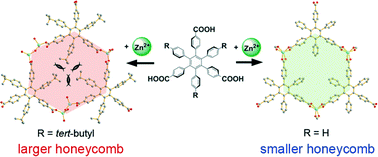Stepwise tuning of the substituent groups from mother BTB ligands to two hexaphenylbenzene based ligands for construction of diverse coordination polymers†
Abstract
Hexaphenylbenzene based tritopic carboxylate ligands H3L1 (1,3,5-tris(4-carboxyphenyl)-2,4,6-tris(4-tert-butylphenyl)benzene) and H3L2 (1,3,5-tris(4-carboxyphenyl)-2,4,6-triphenylbenzene) were applied to synthesize six coordination polymers (CPs) {[Zn4(L1)2(μ2-OH)2(DMA)4(H2O)]·(C2H6O)2(H2O)}n (1), {[Cd3(L1)2(μ2-H2O)2(H2O)4(DMF)2(C2H6O)]·(DMF)(H2O)(C2H6O)2}n (2), {[Cd(L1)(C2H6O)]·(H3O+)(DMF)(C2H6O)}n (3), {[Co3(L1)2(μ2-H2O)(H2O)6(DMF)2(C2H6O)]·(DMF)3}n (4), {[Mn3(L1)2(H2O)5(DMF)4(C2H6O)]·(C2H6O)}n (5), and {[Zn2(L2)Cl(H2O)(DMA)]·(DMA)2(H2O)}n (6) (DMF = N,N-dimethylformamide, DMA = N,N-dimethylacetamide). The CPs were characterized by single crystal X-ray diffraction, infrared spectra (IR), elemental analyses, powder X-ray diffraction (PXRD), and thermogravimetric analyses (TGA). 1 and 2 exhibit two-dimensional (2D) honeycomb bilayer structures based on tetranuclear zinc or trinuclear cadmium clusters. 3 is PH-induced supramolecular isomer with 2, featuring 2D corrugated honeycomb structure. In 4 and 5, only two carboxylate groups coordinate with trinuclear metal clusters to form 1D coordination chains. The chains are further connected through hydrogen bonds between the left carboxylate groups and coordination water molecules to form honeycomb bilayer sheets. 6 exhibits 2D planar honeycomb structure based on Zn2(COO)3 clusters. The different topological networks 1 and 6 are constructed from structurally similar ligands H3L1 and H3L2, showing that structural diversity could be realized by adjusting substituent groups on organic ligands. The photoluminescent behaviours of compounds 1, 2, and 6 and magnetic properties of 4 and 5 were also investigated.


 Please wait while we load your content...
Please wait while we load your content...